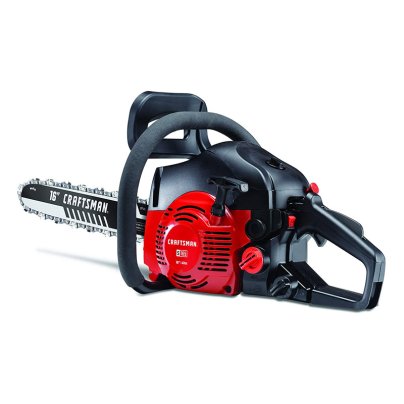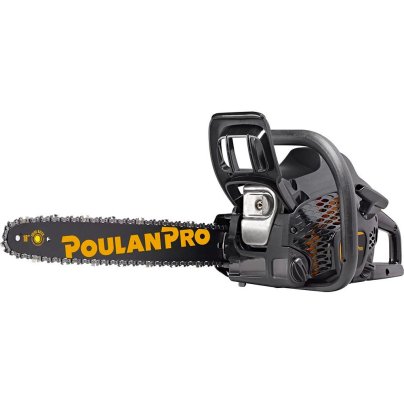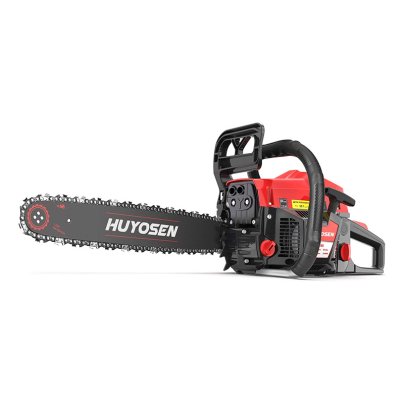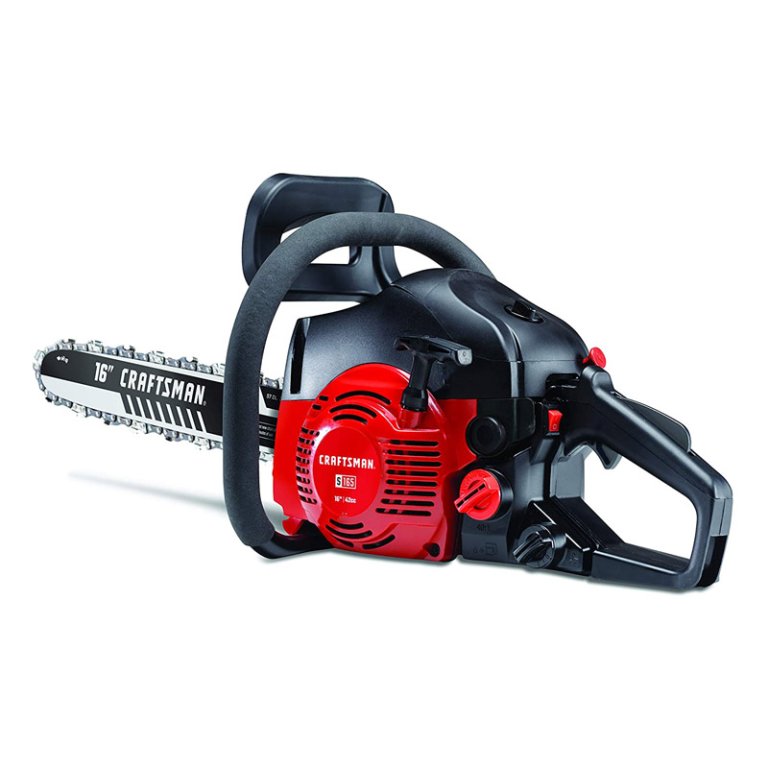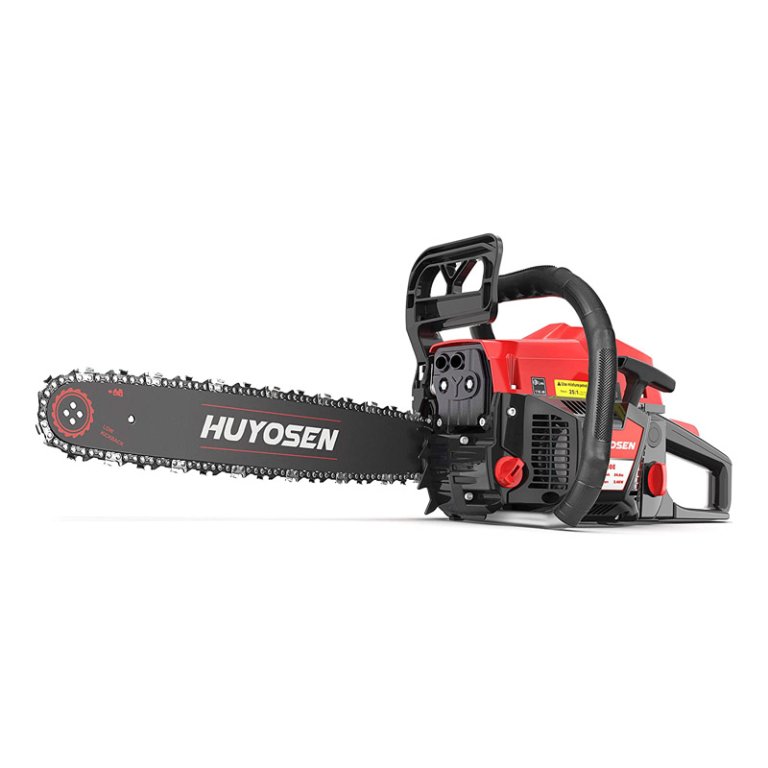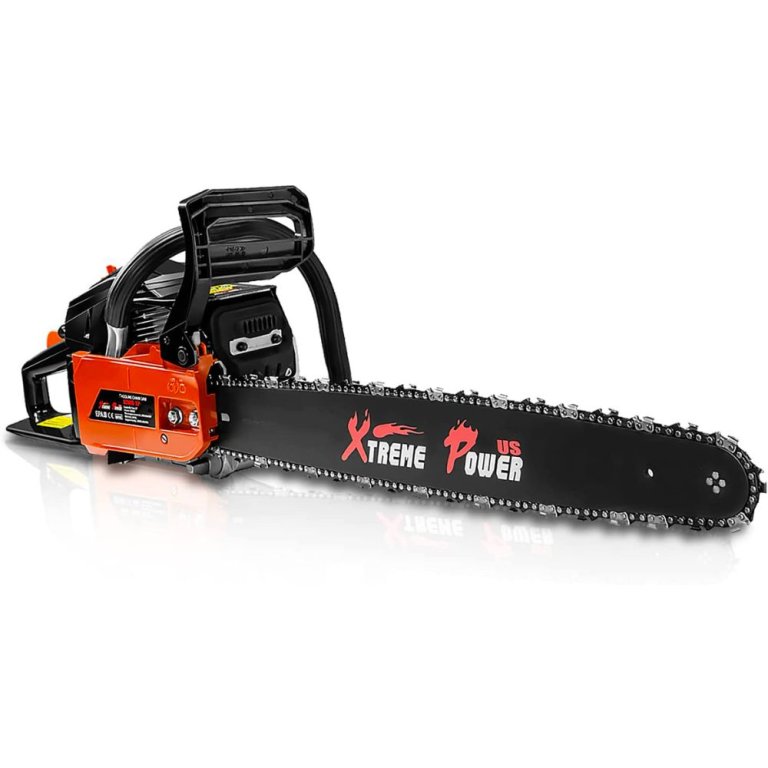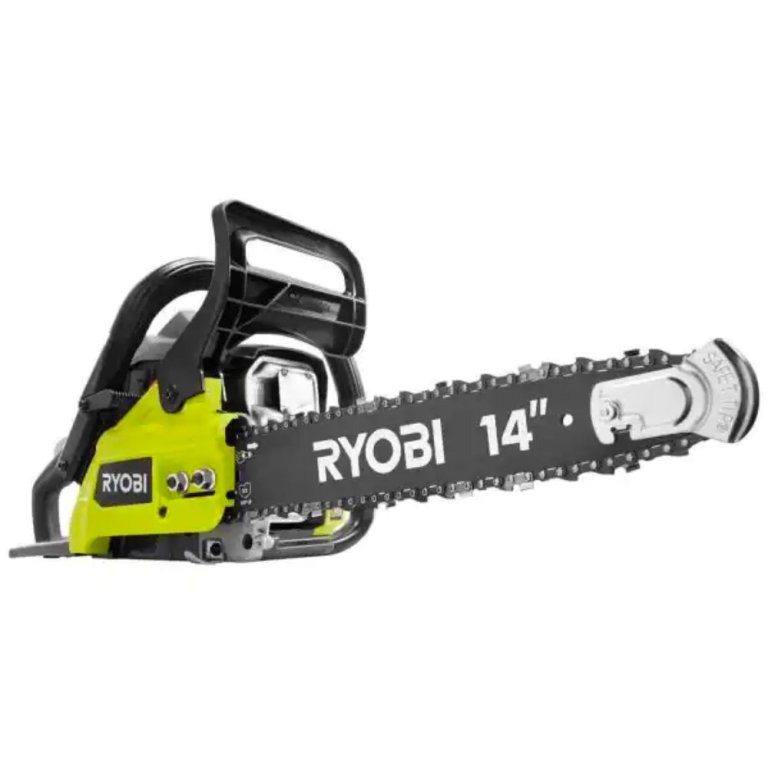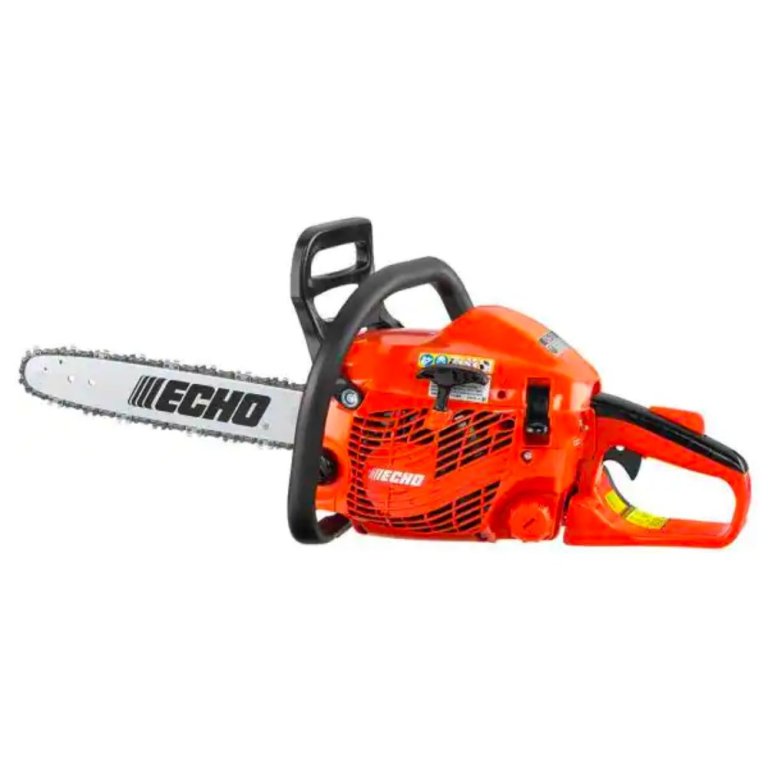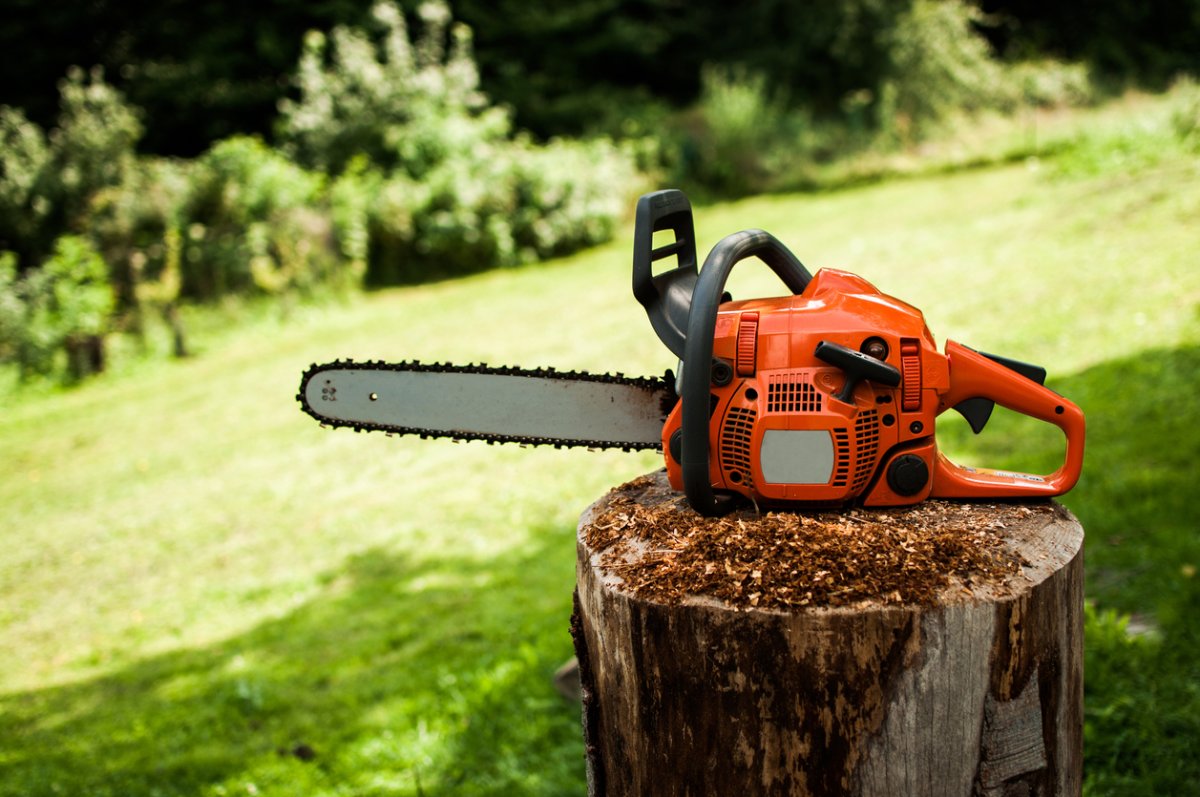
We may earn revenue from the products available on this page and participate in affiliate programs. Learn More ›
Gas chainsaws have a reputation: they’re loud and sometimes hard to use. However, we’ve found that some of the best gas-powered chainsaws prove otherwise. Whether you need a high-powered machine that can fell a large tree or a lighter-duty model for other work around the yard, options are abound on the gas chainsaw market.
Below, we explore some of the top models and explain their technical features to help you select the best gas chainsaw for your yard work.
- BEST OVERALL: Craftsman S165 42cc Full Crank 2-Cycle Gas Chainsaw
- RUNNER UP: Poulan Pro PR4218, 18 in. 42cc 2-Cycle Gas Chainsaw
- BEST VALUE: HUYOSEN 54.6CC 2-Cycle Gas Powered Chainsaw
- UPGRADE PICK: XtremepowerUS 22″ inch 45cc Gas 2-Stroke Chainsaw
- BEST SMALL: RYOBI 14 in. 37cc 2-Cycle Gas Chainsaw
- BEST LIGHTWEIGHT: ECHO 14 in. 30.5 cc Gas 2-Stroke Cycle Chainsaw
- BEST FOR PROFESSIONALS: Husqvarna 24 Inch 460 Rancher Gas Chainsaw
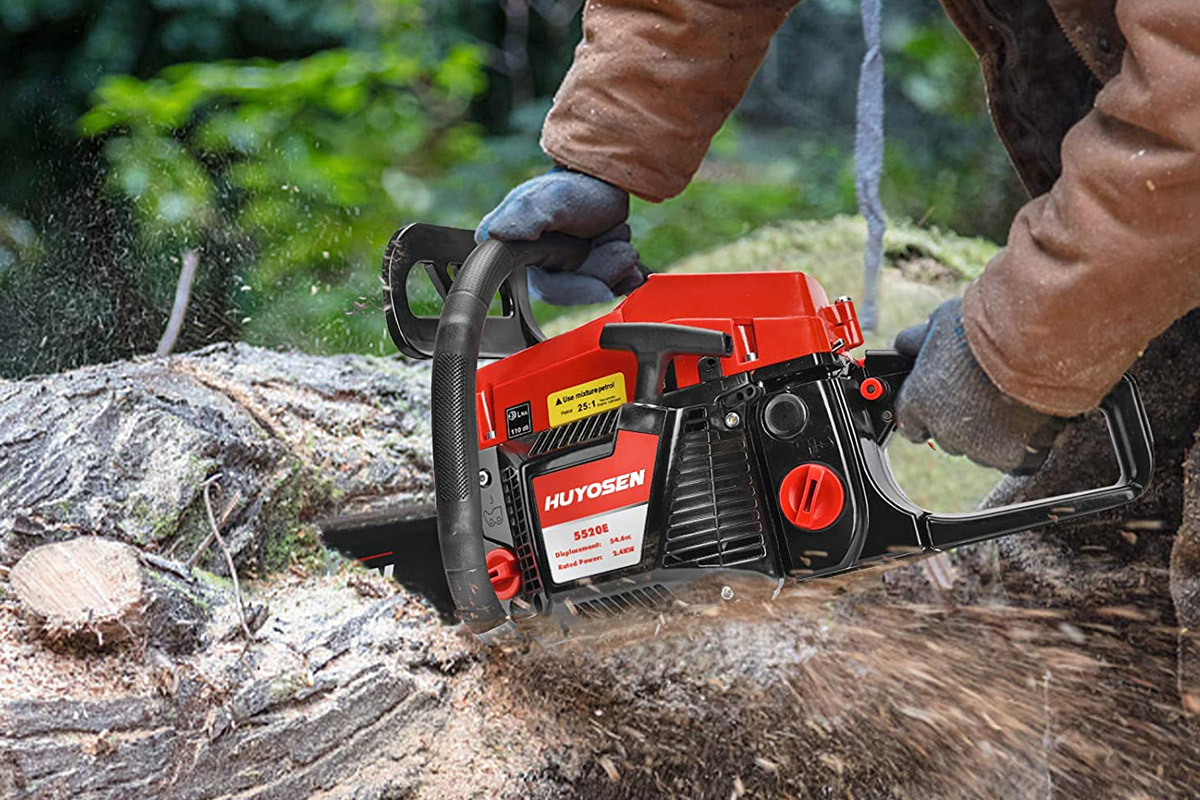
Before You Buy a Gas Chainsaw
Most users will find a gas chainsaw to suit their needs, but that doesn’t mean a gas chainsaw makes the best choice for everyone. First, consider your other options.
Easier-to-use electric chainsaws run quieter, require no maintenance beyond regular oil and chain adjustments, and don’t pollute the environment. Considerably more expensive cordless chainsaws offer a viable alternative to gas chainsaws for those who need to work beyond the reach of a cord. Newer models pack increasingly more power than their older counterparts. So why would you buy a gas chainsaw?
- To fell large trees, a large gas chainsaw remains the only serious option.
- To work far from a power outlet, gas chainsaws require only oil and gas, not expensive spare batteries.
- Environmentally-friendly options abound in response to increasingly tight emissions regulations.
Still unsure whether a gas chainsaw suits your needs? The following section provides more guidance.
What to Consider When Choosing the Best Gas Chainsaw
Before shopping, you’ll need to consider a number of important factors common to all the best chainsaws, regardless of power source. This section explores features of the best gas-powered chainsaws for specific tasks, from heavy-duty jobs to bush trimming, and offers information about motor types and chainsaw bars.
Intended Use
Broadly speaking, gas-powered chainsaws fall into three groups, based on the type of work they can handle: light-duty, general purpose, and professional.
- Light-duty gas chainsaws. Relatively small tools, they compare in size and strength to their corded and cordless counterparts. Easy to handle, they make a good tool for tasks like pruning trees or thinning out undergrowth.
- General purpose chainsaws. A bit larger than their light-duty counterparts, these chainsaws can tackle most of the work that a medium to large yard demands. In addition to tasks like clearing storm-damaged branches or cutting logs into firewood, they can handle modest tree-felling duties.
- Professional chainsaws. These heavy-duty tools pack the power and durability to operate all day long. They’ll handle the same tasks as light-duty and general purpose chainsaws and also fell most trees except for extremely large ones.
Motor
Chainsaw motors fall into two categories: two-stroke motors, also called two-cycles, and four-stroke motors or four-cycles.
- Two-stroke chainsaws. Lighter, less complicated, and less expensive, they usually run at higher revolutions per minute (rpm), so they generate decent power for their size. However, this also makes them noisier, increases fuel consumption, and produces higher emissions.
- Four-stroke chainsaws. Heavier, more complex, and less powerful for the same cylinder size, these tools run cleaner. They rank as more fuel efficient and often as more durable, too.
Historically, light-duty and general purpose chainsaws come with two-stroke motors, and they remain the most popular. Heavy-duty professional models more often come with four-stroke motors. Two-stroke models often struggle to meet CARB- and EPA-emission regulations, which makes them illegal in more than a dozen states. As a result, some manufacturers have developed lower emission two-stroke engines that rival their four-stroke counterparts.
Chainsaw Bar
A description of any gas chainsaw likely includes the bar length in inches. Sometimes referred to as the “guide bar,” this is the steel guide plate the chain runs around. As a rule of thumb, a light-duty chainsaw bar runs from 12 to 14 inches long, general purpose chainsaw bars run from 16 to 20 inches, and professional model bars measure 22 inches or more. The largest chainsaw bars may exceed 48 inches.
However, exceptions exist. Some of the best chainsaws for professional use incorporate shorter bars for added maneuverability. Often contractors in climbing harnesses use these saws to work among branches at height.
Strictly speaking, a chainsaw with a 12-inch bar and a good blade should cut through a 12-inch tree. In practical terms, however, maximum cutting capacities usually run a couple of inches shorter than bar length. When shopping for a replacement chain, keep in mind that the bar and chain lengths must have the same measurements.
Safety
Before getting to work, learn how to use a chainsaw safely. If at all possible, learn from someone with practical experience.
Always wear appropriate safety gear when operating a chainsaw. A face shield can help protect you from oftens-sharp flying debris. Hearing protection also makes a smart choice. Wear a hard hat to protect against falling branches. And don’t forget solid footwear, preferably with steel toe caps, and tough work gloves. Chainsaw chaps also make a good addition to any arsenal of protective gear. Check out our complete list of equipment.
When using a chainsaw, always keep children and pets out of the area. Never work with a chainsaw if you don’t feel 100 percent fit and alert. This can lead to improper operation, which can cause serious injury.
Additional Features
A variety of minor features can make the difference between a good gas chainsaw and the best gas chainsaw. Any chainsaw comes with some level of vibration, but better chainsaws use special engine mounts to keep it to a minimum. Spring-mounted handles further buffer against vibration. Just make sure the chainsaw handle allows sufficient space for a comfortable grip with gloved hands.
The front handle should incorporate a chain brake; never buy a chainsaw without one. Inertia-activated models operate automatically at a sudden movement. Other gas-powered chainsaws use manual chain brakes, which immediately stop the chain from rotating when pushed forward. Also look for a slip-on chain guard.
A few of the best gas chainsaws feature tool-free chain adjustment. Instead of tools, users employ a large knob on the side of the machine to make necessary adjustments. However, most chainsaws still need a wrench and/or screwdriver. An automatic oil supply system for the chain, or automatic chain oiler, makes a valuable bonus.
You’ll need to change the fuel filter annually. You might need to change the air filter more frequently in dry and dusty environments, which heavy use can sometimes create. While not major tasks, make sure they won’t be too hard to perform on the model you choose.
Our Top Picks
Now that you’ve learned about the major features, let’s put that knowledge into practice and check out some of the best gas chainsaws available.
Best Overall
Craftsman S165 42cc Full Crank 2-Cycle Gas Chainsaw
Pros
- Sized for the average user
- 3-point vibration dampening
- Designed to reduce operator fatigue
- EPA and CARB compliant
Cons
- Reliable, but not for cutting larger trees
Product Specs
- Bar Length: 16 inches
- Motor Type: 42cc, 2-stroke
- Weight: 15.22 pounds
Craftsman makes a good overall chainsaw in terms of quality, performance, and reliability. While it doesn’t excel in any one area, it delivers what most people need, which makes it the most reliable chainsaw on this list.
The 16-inch bar, perhaps the optimum size for the average user, offers a good balance between maneuverability and cutting capacity. It features a tough but light polypropylene chassis. A three-point anti-vibration mounting helps reduce operator fatigue. An easy-start, two-cycle, 42cc motor delivers clean, consistent power and meets CARB and EPA standards.
Craftsman’s full crank features an inertia-activated chain brake system, an adjustable automatic chain oiler, and comes with its own case. It weighs a relatively modest 15.22 pounds.
Get the Craftsman chainsaw at Amazon, Walmart, and Ace Hardware.
Runner Up
Poulan Pro PR4218, 18 in. 42cc 2-Cycle Gas Chainsaw
Pros
- Patented OxyPower engine
- Anti-vibration handle
- Carry case included
Cons
- Chain adjustment could be easier
- A few starter cord issues
Product Specs
- Bar Length: 18 inches
- Motor Type: 42cc, 2-stroke
- Weight: 13.25 pounds
Poulan Pro puts up a good fight for the title of best gas chainsaw for general-purpose use. A little lighter than Craftsman’s model, it features the capability of cutting larger trees and logs.
A 42cc, 2-stroke OxyPower engine delivers strong performance and fuel efficiency. Its emissions meet EPA standards, though not the stricter CARB requirements. As expected on a quality tool, this chainsaw features an inertia chain brake and automatic chain oiler.
Chain adjustment requires use of the onboard scrench (a screwdriver-wrench hybrid), and some users complain the process could be simpler. Some reports say that the pull cord to start the machine is prone to snapping.
Get the Poulan Pro chainsaw on Amazon.
Best Value
HUYOSEN 54.6CC 2-Cycle Gas Powered Chainsaw
Pros
- Powerful engine
- Automatic chain oiler
- Terrific value for money
Cons
- Quite heavy
- Occasional starting issues
Product Specs
- Bar Length: 20 inches
- Motor Type: 54.6cc, 2-stroke
- Weight: 19.98 pounds
Even without the surprisingly low price, Huyosen’s chainsaw makes an attractive proposition. A powerful 54.66cc, EPA-compliant motor, and a 20-inch chain make for great all-around cutting ability.
Its competitive feature set includes anti-kickback pawls for improved control; automatic chain oiling, and front handle anti-vibration mounting. Chain adjustment requires a tool, similar to more expensive models.
While not poorly made, Huyosen’s quality does not rival that of its bigger brand rivals. A bit heavy for its size, the chainsaw makes a good choice for the occasional user, but not for everyday forestry work. Some reports indicate that starting can be hit-or-miss, though it doesn’t seem to be a common problem.
Get the HUYOSEN chainsaw on Amazon and at Walmart.
Upgrade Pick
XtremepowerUS 22" inch 45cc Gas 2-Stroke Chainsaw
Pros
- Designed to prevent dust from entering engine
- EPA compliant for low emissions
Cons
- Tends to overheat with extended use
- Not CARB compliant
Product Specs
- Bar Length: 22 inches
- Motor Type: 45cc, 2-stroke
- Weight: 19 pounds
Designed with all-day productivity in mind, XtremepowerUS’s chainsaw offers an impressive 22-inch bar and 45cc engine power. Electronic ignition and automatic choke make for an easy start.
Minimal vibration levels help reduce user fatigue. For safety, this model features an anti-kickback chain combined with a manual chain brake and quick-stop button. Its EPA-compliant EcoBoost motor keeps emissions low, though it doesn’t meet the more stringent CARB standard. This easy-to-maintain chainsaw weighs in a little on the heavy side at 19 pounds.
Get the XtremepowerUS chainsaw at Amazon, Walmart, and The Home Depot.
Best Small
RYOBI 14 in. 37cc 2-Cycle Gas Chainsaw
Pros
- Compact but powerful
- Safe-T-Tip kickback prevention
- Good vibration isolation
Cons
- Modest bar length
- Starting can be erratic
Product Specs
- Bar Length: 14 inches
- Motor Type: 37cc, 2-stroke
- Weight: 10 pounds
RYOBI has earned a reputation for high-quality cordless and corded electric chainsaws. This 14-inch tool makes an excellent addition to their lineup. Small enough to manage, it weighs just 10 pounds, but the 37cc motor packs enough power to deliver strong cutting ability.
Safety features include three-point isolation to limit vibration, automatic chain oiling, and an inertia-activated chain brake. A unique Safe-T-Tip device on the end of the bar helps prevent dangerous kickback.
Get the RYOBI chainsaw on Amazon and at The Home Depot.
Best Lightweight
ECHO 14 in. 30.5 cc Gas 2-Stroke Cycle Chainsaw
Pros
- Excellent build quality
- Easy to handle
- Ideal for pruning at height
Cons
- Expensive
- Included chain could be better
Product Specs
- Bar Length: 14 inches
- Motor Type: 30.5cc, 2-stroke
- Weight: 8.1 pounds
Compact, lightweight chainsaws have two main advantages. First, they are easy to use. Second, they offer excellent maneuverability in situations or locales where a larger chainsaw would struggle: chopping through dense woodland, pruning branches from a ladder, or working in a climbing harness. Echo delivers both.
At just 8.1 pounds, this 14-inch model ranks as the lightest in its class. The 30.5cc engine meets the criteria for EPA compliance. It includes the standard features, such as chain brake, automatic chain oiler, and anti-vibration handle. Take note, however, frequent users of this saw prefer to replace the adequate included chain with a better alternative. Echo has a great reputation for quality and reliability, but that reputation comes with a premium price tag.
Get the ECHO chainsaw on Amazon and at The Home Depot.
Best for Professionals
Husqvarna 24 Inch 460 Rancher Gas Chainsaw
Pros
- Larger bar and motor than the competition
- Great for use in heavily-wooded areas
- EPA and CARB compliant
Cons
- Pricey
Product Specs
- Bar Length: 24 inches
- Motor Type: 60.3cc, 2-stroke
- Weight: 22.6 pounds
Husqvarna has a reputation for some of the best gas-powered chainsaws that few others rival. Its Rancher model lives up to that reputation. With abilities on par with the best professional chainsaws on the market, Husqvarna might just have made the most powerful chainsaw money can buy.
Its 24-inch bar partners with a potent 60.3cc motor. But this machine offers more than brute force. The easy-to-start X-Torq engine offers competitive fuel consumption and reduced emission levels that satisfy both CARB and EPA requirements.
Husqvarna’s heavy-duty chainsaw has all the expected safety and operator comfort features, including an inertia-activated chainsaw chain brake and the LowVib system, designed to reduce vibration levels for the chainsaw user. The most expensive chainsaw on our list, this model provides engine power, durability, and productivity that measure up to the price.
Get the Husqvarna chainsaw on Amazon.
Our Verdict
While the best gas chainsaw depends on the size and number of trees you want to cut or groom, the Craftsman S165 chainsaw ranks as the top gas-powered model. To slice through larger trees, invest in a 22-inch chainsaw bar like that on the XtremepowerUS chainsaw.
How We Chose the Best Gas Chainsaws
These recommendations for the best gas chainsaw span a variety of sizes to suit the range of needs of the average user, whether those needs include pruning a few trees or felling a number of trees on a wooded property.
We narrowed our research to focus primarily on chainsaws with two-stroke engines—some of the most popular options on the market because of their size and weight, maneuverability, and versatility to tackle light-duty or general tasks, depending on the motor’s power output.
Our favorite models feature bars spanning anywhere from 12 to 24 inches in length to accommodate a range of tree diameters. While not all two-stroke gas engines meet environmental standards, the team prioritized models with compliance to Environmental Protection Agency (EPA) and (California Air Resources Board) CARB emission standards.
Not surprisingly, a number of the most reliable chainsaw makers were on our radar. Always remember that the right gas chainsaw for you will depend on what you’re using it for.
The Advantages of Owning a Gas Chainsaw
Electric chainsaws remain a viable choice for small urban gardens, particularly in areas with noise restrictions. Additionally, while small chainsaws do a good job pruning small trees, they can’t stand up to everyday wood cutting.
Gas chainsaws make the best choice to deal with sizable tree limbs, woodland or forestry management, or even a large log pile. Professionals favor them because they offer:
- Unrestricted movement: With a tank of gas and a can of oil, the user can go anywhere. There’s no power cord to worry about and no need to charge batteries.
- Unrivaled performance: Gas powered chainsaws invariably outperform electric chainsaws when it comes to power.
- Durability: Although difficult to generalize, a properly-maintained, high-quality gas chainsaw usually outlasts a battery-operated chainsaw.
FAQs
Though you’ve learned about the features and benefits of these tools, you may still have some questions. Check out answers to the most frequently asked questions about the best gas chainsaws.
Q: What fuel do I need for my gas chainsaw?
Go with regular unleaded gas. Chainsaws aren’t particularly fussy, but premium gas is probably a bit rich. If you have a two-stroke gas chainsaw, you must add oil to the fuel before use. Check the owner’s manual for correct proportions. Four-stroke gas powered chainsaws hold oil in a separate reservoir.
Q: How do I start a gas chainsaw?
Usually, you prime the carburetor with a couple of gentle pulls on the cord with the motor off. Then turn it on and pull it again to fire it up. Modern gas saws normally make this quick and easy. However, read the owner’s manual. Many complaints about starting difficulties result from user error.
Q: Is the weight of a chainsaw important?
Small chainsaws are usually very manageable, but larger models can get heavy. Whether this becomes a problem for you depends on your physical strength, whether you need to work off the ground, or how long you must use the chainsaw.
Q: Can I modify the chainsaw exhaust to make the machine quieter?
To run properly, the motor relies on back pressure from the exhaust. Removing or modifying it will impact the chainsaw’s performance negatively.
Q: How do I clean a chainsaw gas cap vent?
Simply blowing through the cap often clears small obstructions. You can do it yourself or use compressed air from a can. Otherwise, carefully disassemble it and clean the various components. Some have a small filter that might need replacement.
